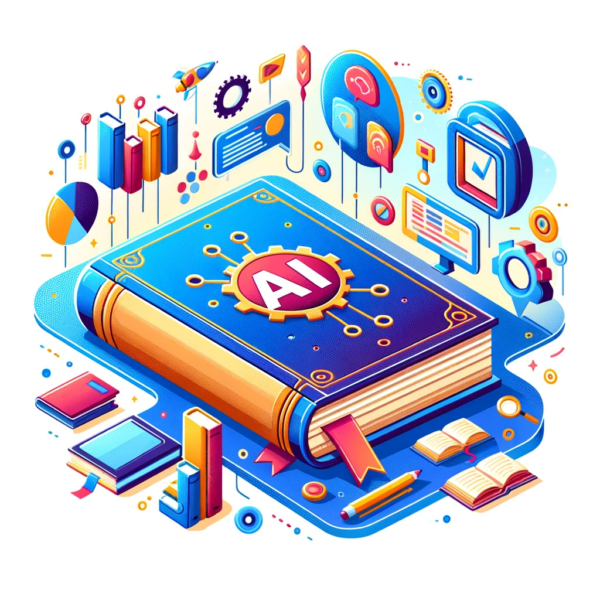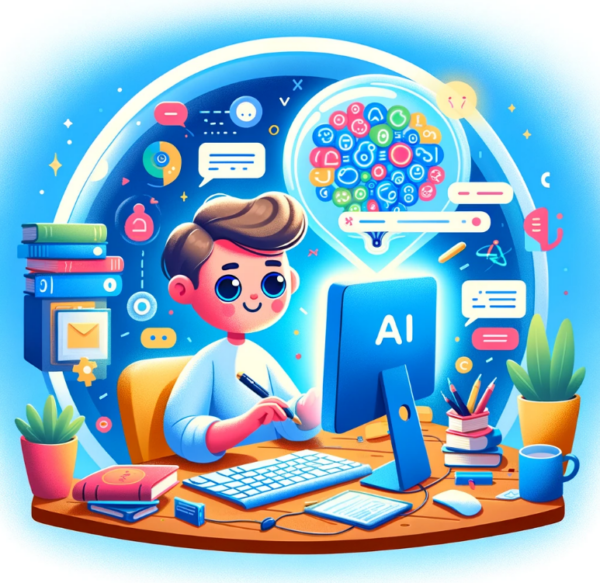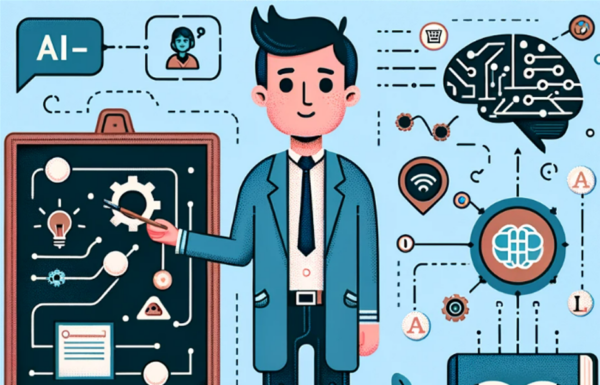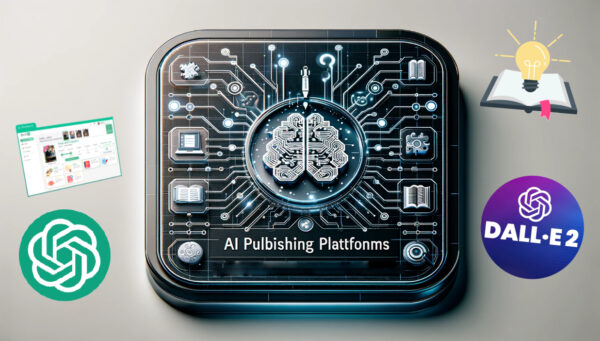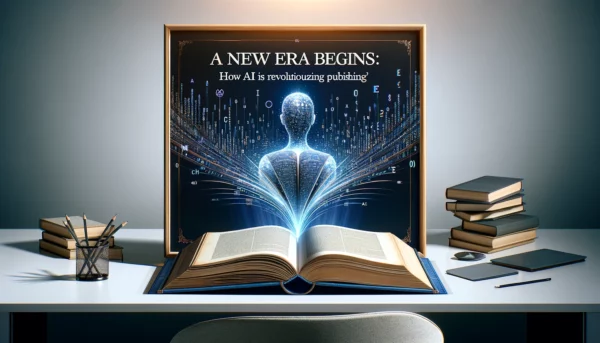The book publishing industry, continually adapting to evolving demands and technologies, now stands at a fascinating intersection of tradition and innovation, heavily influenced by the digital transformation and the integration of AI in the publishing industry.
AI, focused on creating intelligent machines for tasks typically needing human intelligence, has transitioned from a futuristic concept to a present-day reality, significantly impacting various sectors, including book publishing.
In this context, the role of AI is multifaceted and deeply transformative. The AI in publishing industry is experiencing a surge in AI-driven tools and platforms, reshaping everything from content creation to marketing and distribution.
This article explores the exciting landscape where AI meets traditional publishing. It delves into how AI technologies are revolutionizing the book publishing industry, analyzing their impact on various facets of publishing, from manuscript development to reader engagement.
Start Your Publishing Journey FOR FREEBrief History of Book Publishing: From Traditional Methods to Digital Transformation
The story of book publishing is a narrative of continual evolution and adaptation, reflecting the changing tides of culture, technology, and society. The journey began with handwritten manuscripts in ancient times, laboriously copied and preserved by scribes.
This process was revolutionized by the invention of the printing press by Johannes Gutenberg in the 15th century, which democratized knowledge by making books more accessible and affordable. The ensuing centuries witnessed the rise of the publishing house, a system that not only printed but also marketed and distributed books, shaping the modern publishing industry.
The 20th century brought further advancements with the onset of mass-market paperbacks, making literature even more widely available. However, the most significant transformation in publishing began with the advent of digital technology.
The late 20th and early 21st centuries saw the rise of e-books and digital printing, fundamentally altering how books are produced, distributed, and consumed. The introduction of e-readers and tablets further propelled this digital shift, enabling instant access to vast libraries of content and ushering in a new era of convenience and connectivity in reading.

The Evolution of AI: Key Milestones Relevant to Publishing
The origins of AI can be traced back to the 1950s, with the seminal work of pioneers like Alan Turing and John McCarthy, who laid the foundational theories and concepts. However, it was not until the late 20th and early 21st centuries that AI began to make substantial inroads into practical applications, fueled by advancements in computational power and data availability.
In the context of publishing, the relevance of AI became pronounced with the development of natural language processing (NLP) and machine learning. These technologies enabled computers to understand, interpret, and generate human language in a way that was previously unimaginable.
Key milestones include the development of sophisticated algorithms capable of analyzing text for grammar and style, the introduction of predictive analytics to gauge market trends and reader preferences, and the advent of AI-driven content generation tools.
Additionally, AI’s ability to process and analyze large datasets has been instrumental in understanding reader behavior and preferences, a tool that has become invaluable in the marketing and distribution of books. The integration of AI in these areas represents a significant shift from traditional methods, offering unprecedented efficiency and insights into the publishing process.
Start Your Publishing Journey FOR FREEAI in Manuscript Development and Editing
The advent of Artificial Intelligence (AI) in the realm of manuscript development and editing marks a significant leap in how authors and publishers approach the creation of literary content. AI’s integration into these processes is not just about automating tasks but about augmenting the creative and editorial capabilities of humans.
AI-driven Tools for Manuscript Writing: Enhancing Creativity and Efficiency
AI’s role in manuscript writing is one of a creative collaborator. Advanced AI writing assistants are now capable of providing suggestions for plot development, character arcs, and even thematic elements.
These tools use machine learning algorithms to analyze vast databases of literature, enabling them to offer inputs that are contextually relevant and creatively inspiring.
For writers, this means a significant enhancement in creativity and efficiency. AI can help overcome writer’s block, suggest alternative storylines, or even generate descriptive prose, all while maintaining the author’s unique voice and style.
Automated Editing Software: Grammar, Style, and Consistency Checks
Editing is a critical phase in the book publishing process, ensuring the manuscript is polished and reader-friendly. AI has transformed this phase with automated editing software.
These tools go beyond basic grammar and spell checks; they are sophisticated enough to analyze complex aspects of writing such as style, tone, and narrative consistency.
Some AI editors can help human editors by providing feedback on sentence structure, readability, and even point out potential plot inconsistencies or factual inaccuracies. This level of detailed analysis not only enhances the quality of the manuscript but also significantly reduces the time and resources spent on manual editing.
Predictive Analytics for Content Success: Analyzing Reader Preferences and Market Trends
The integration of AI tools in these early stages of book production is setting a new standard, one where technology and human creativity work in tandem to produce literature that resonates with readers and succeeds in the market.

AI in Book Design and Layout
In the visually driven world of book publishing, the design and layout of a book play a critical role in attracting and engaging readers. The emergence of AI in this arena has introduced a new era of efficiency and customization. This section examines how AI is being utilized to revolutionize the visual aspects of book publishing, focusing on automated layout and design tools, and AI’s influence on cover design.
Automated Layout and Design Tools: Streamlining the Visual Aspect of Book Publishing
AI has brought a significant transformation in book layout and design, traditionally areas that required a high degree of manual effort and artistic intuition.
Automated layout tools powered by AI algorithms are now capable of arranging text, images, and other elements in a visually appealing and reader-friendly format. These tools consider factors such as readability, the balance of white space, and aesthetic appeal to create layouts that are both functional and attractive.
One of the key benefits of these AI-driven tools is their ability to adapt layouts for different formats, such as e-books, print books, and audiobooks, with minimal human intervention.
This flexibility is particularly valuable in an industry that is increasingly catering to a diverse range of reading platforms. Moreover, these tools can significantly reduce the time and cost associated with the design process, allowing publishers to allocate resources more efficiently.
AI in Cover Design: Tailoring Designs to Market Trends and Reader Preferences
The book cover, often the first point of interaction for a reader, holds substantial sway in the reader’s decision to engage with a book. AI’s role in cover design is becoming increasingly influential, blending artistic creativity with data-driven insights. AI algorithms can analyze current market trends, genre-specific aesthetics, and even reader preferences to suggest cover designs that are likely to resonate with the target audience.
These AI systems draw on a vast database of successful book covers, analyzing elements such as color schemes, imagery, typography, and overall design style. By understanding what works for a particular genre or reader demographic, AI can assist designers in creating covers that are not only visually striking but also aligned with market expectations and reader interests.
This blend of AI with traditional design processes is enabling a more strategic approach to cover design, one where the artistic aspects are informed by empirical data. As a result, publishers can optimize the appeal of their books, ensuring that each title stands out in a crowded market and connects effectively with its intended audience.
Through these advancements in layout and design, AI is streamlining the creative process in book publishing, ensuring that the visual presentation of books meets both aesthetic standards and market demands. This integration of technology in the design phase is not only enhancing efficiency but also opening new possibilities for creative expression in the publishing industry.

AI in Marketing and Sales
The integration of Artificial Intelligence (AI) into the marketing and sales strategies of the book publishing industry marks a significant shift towards a more data-driven, personalized approach. In a market where reader attention is highly coveted and competition is fierce, AI tools offer publishers and authors an edge in reaching and engaging their target audience.
Personalized Marketing: Using AI to Target Readers
Personalized marketing, powered by AI, has revolutionized the way publishers connect with readers. AI algorithms can analyze vast amounts of data, including past purchase history, browsing behavior, and reader preferences, to create highly targeted marketing campaigns. This data-driven approach enables businesses in the publishing industry to tailor their messaging and recommendations to individual readers, increasing the relevance and effectiveness of their marketing efforts.
AI-powered tools can segment audiences based on specific interests, reading habits, and demographic data, allowing for more nuanced and effective marketing strategies. For instance, AI can help identify readers who are fans of a particular genre or author and target them with personalized recommendations or promotional content. This level of personalization not only enhances the reader’s experience but also increases the likelihood of book sales by presenting readers with options that align closely with their interests.
AI in Sales Forecasting: Predicting Market Trends and Reader Demand
Sales forecasting is crucial for companies in the publishing industry to effectively manage inventory, allocate resources, and plan future publications. AI significantly enhances this process by providing accurate predictions based on comprehensive market analysis. These AI systems analyze historical sales data, current market trends, reader reviews, and even social media sentiment to forecast future book sales.
This predictive capability enables publishers to make informed decisions about print runs, distribution, and marketing strategies. By anticipating market demand, publishers can optimize their stock levels, reducing the risk of overstocking or stockouts. AI-driven sales forecasting also aids in identifying emerging trends, allowing publishers to stay ahead of the curve in a rapidly evolving market.
Automated Recommendation Systems: Enhancing Discoverability and Reader Engagement
In the digital age, where online bookstores and e-libraries offer an overwhelming array of choices, discoverability is a key challenge. AI-powered recommendation systems address this by helping readers find books that match their interests and reading patterns. These systems analyze user data, including previous purchases, ratings, and browsing history, to suggest books that readers are likely to enjoy.
Such recommendation engines are integral to platforms like Amazon and Goodreads, where they significantly enhance the user experience by offering personalized suggestions. For publishers and authors, these systems increase the visibility of their books, particularly for new or lesser-known titles, thus driving sales and engagement. By connecting the right reader with the right book, AI not only boosts sales but also fosters a more engaging and satisfying reading experience.

AI in Distribution and Supply Chain Management
The incorporation of Artificial Intelligence (AI) into the distribution and supply chain aspects of the book publishing industry represents a significant advancement in ensuring efficiency and responsiveness to market demands.
AI technologies are playing a crucial role in streamlining distribution channels and optimizing inventory management, two critical components that directly impact the availability and timely delivery of books to the market. This section explores how AI is reshaping distribution and inventory management in book publishing, focusing on AI-driven logistics and predictive analysis for inventory control.
AI-driven Logistics: Streamlining Distribution Channels
Efficient distribution is key to ensuring that books reach their intended markets promptly and cost-effectively. AI-driven logistics solutions are transforming the distribution network by optimizing routes, managing warehouse operations, and enhancing the overall coordination of the supply chain. These AI systems can analyze vast amounts of logistics data to identify the most efficient transport routes, predict potential delays, and suggest alternative strategies to mitigate disruptions.
In warehouse management, AI-powered robots and automated systems are being employed to handle tasks such as sorting, packing, and storing books. These technologies not only speed up the process but also reduce the likelihood of errors, ensuring that the right books are dispatched to the right places. Furthermore, AI can assist in managing cross-border logistics, navigating complex customs and regulatory environments, which is particularly important in the global book market.
Inventory Management: Predictive Analysis for Efficient Stock Handling
Inventory management is a delicate balance for publishers, requiring them to have enough stock to meet demand without overstocking, which ties up capital and resources. AI and predictive analytics are revolutionizing this aspect by providing accurate forecasts of book demand. These systems analyze historical sales data, market trends, seasonal variations, and even social media trends to predict which titles will be in demand.
This predictive capability allows publishers to make data-driven decisions about print runs and stock replenishment, reducing the risk of unsold inventory and ensuring popular titles remain available. AI can also help in identifying when to phase out older editions or when to ramp up the production of books that are gaining traction. By optimizing inventory levels, AI not only reduces costs but also improves the responsiveness of the supply chain to market changes.
The integration of AI into distribution and supply chain management in book publishing is leading to a more agile, efficient, and responsive system. The ability to analyze and predict market dynamics accurately, coupled with enhanced operational efficiency, positions publishers to better meet the demands of a rapidly changing market. As AI technologies continue to advance, their role in streamlining the distribution and inventory management processes will become increasingly pivotal, offering a competitive edge in the dynamic world of book publishing.

Future of Artificial Intelligence in Book Publishing
As we look toward the horizon of the book publishing industry, it’s evident that Artificial Intelligence (AI) will continue to play a transformative role. The future of AI in publishing is not just about the continuation of current trends, but also about the emergence of new technologies and applications that could further reshape this landscape. This section explores the potential future developments in AI that could impact publishing, and offers predictions on how these advancements might unfold in the next decade.
Natural Language Processing and Other Emerging AI Technologies and Their Potential Impact on Publishing
The next wave of AI technologies in publishing is likely to be characterized by even greater levels of sophistication and integration. One area of potential growth is in advanced natural language generation (NLG) and understanding (NLU), which could see AI not just assisting in writing and editing, but also in creating complex, nuanced narratives. This could open up possibilities for new genres of AI-assisted literature and expand the scope of personalized storytelling.
A particularly promising development in this area is the advancement of natural language processing (NLP). NLP technologies are becoming increasingly adept at understanding and mimicking human language and style. This has the potential to revolutionize content creation in publishing, enabling AI to draft more sophisticated and varied content, from news articles and educational material to creative fiction.
As NLP technology continues to evolve, we might see AI playing a more collaborative role in writing, offering authors not only editorial assistance but also creative suggestions and story development ideas.
Another emerging technology is AI-driven augmented and virtual reality (AR/VR) experiences. These technologies could revolutionize the way readers engage with books, offering immersive experiences that extend beyond the page. Imagine reading a historical novel while being able to explore the world in which it’s set through a virtual reality environment, or an educational book that uses AR to bring concepts to life.
Predictions and Trends for AI Powered Tools in the Next Decade within the Industry
Looking ahead to the next decade, several key trends are likely to shape the role of AI in publishing:
- Personalization at Scale: AI will enable publishers to offer personalization in both content creation and marketing. This could mean books tailored to individual reader preferences or marketing campaigns that are highly targeted based on sophisticated reader profiles.
- Enhanced Interactive Experiences: With advancements in AI, interactive e-books and other digital formats could become more sophisticated, offering readers an engaging and interactive experience. This might include AI-driven storylines that change based on reader choices.
- AI as a Collaborative Creative Partner: AI’s role may evolve from a tool to a collaborative partner in the creative process, aiding authors in exploring new ideas, scenarios, and even co-creating content in real-time.
- Ethical and Responsible AI Development: As AI becomes more integral to publishing, there will be an increased focus on ethical considerations, ensuring AI is used responsibly and transparently, especially in content creation and data handling.
- Integration Across the Publishing Value Chain: AI’s integration will likely become more seamless and holistic, impacting every stage of the publishing process, from manuscript development to post-publication analysis.
As AI technologies evolve and mature, they promise not only to streamline existing processes but also to open doors to new possibilities in how stories are told and experienced. The challenge and opportunity for the industry will be in harnessing these advancements while maintaining the core values and traditions that have long defined the world of books.
Start Your Publishing Journey FOR FREE